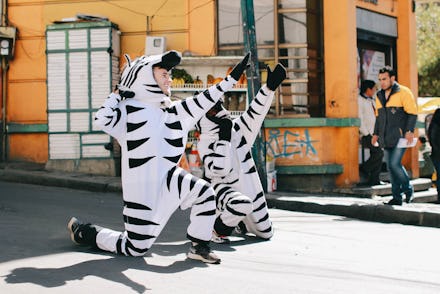La Paz's beloved zebra crossing guards endure — here's what it's like to be one for a day

It was late April, and the pulse of morning rush hour traffic was just beginning to pick up as I trotted out onto the street, my tail dragging behind me. I had just finished an hour-long orientation complete with a guided meditation and role play designed to transform me into my new identity for the day: a zebra.
As the traffic light turned red, I promptly took my place on Avenida 16 de Julio, at one of the busiest intersections in the center of La Paz, Bolivia, and began to implement what I'd been trained to do. I danced up to the nearest car, my arms extended out front to signal "stop" as a young boy wearing a backpack and a baseball cap crossed the street with his mother. The boy looked at me, and sprung from his mother to give me a hug. His mother and I each held one of the boy's hands as we ushered him across the street.
Another woman followed, smiling as she met my high-five in the air and continued on her way. When the light turned green, I kept pedestrians at bay as the cars thrust forward.
La Paz and zebras go hand-in-hand
For years, these striped crossing guards — inspired by the city's black and white crosswalks — have served as an iconic rush hour image in La Paz, a mountainous city nestled at an altitude of nearly 12,000 feet. The vast majority of the city's 2.3 million residents commute by walking, or packing into the thousands of unregulated mini-buses that criss-cross the city's steep and narrow streets, despite La Paz having the largest urban cable car system in the world. Bolivia, the poorest country in South America, has among the highest death rates from road traffic accidents in the entire continent, just barely edged out by the famously harrowing roads of nearby Brazil.
What started as a modest 25-zebra experiment spread out among a handful of La Paz intersections fifteen years ago has now ballooned into "Educadores Urbanos Cebras" (Zebra Urban Educators), a mammoth operation that employs 415 people in three cities across the country. To city officials, the zebras are an example of the cost-saving solutions cities in developing countries are finding to tackle major urban issues. The program could serve as a model for other countries looking to do the same.
It only takes a short walk around La Paz to notice the many murals adjoining office buildings, schools and restaurants, bearing tribute to the zebras.
"I honestly can't imagine this city without our zebras," Alvaro Bermudez, a lawyer born and raised in La Paz who regularly encounters them during his commute, said. He recalls the cold reception the zebras received when first introduced in 2001, but how it gradually warmed as the zebras started interacting with commuters.
"Zebras represent love, kindness and respect," Bermudez said. "They are everything we strive for as Bolivians."
Not just a zebra suit
Beneath each plush zebra suit is an "ambassador" between the ages of 16 and 30. Supervisors hand-pick at-risk youth to teach pedestrians and motorists to coexist on the roads. The zebras require two months of training before they can hit the streets, all with the dual purpose of embodying the ethos of the ideal zebra, and traffic safety skills needed to keep accidents from occurring.
While they make less than the minimum wage, zebras are also provided with other benefits aimed at pushing them into better opportunities, like professional mentorship and trainings to help them find permanent work. They also receive free health insurance.
Goya Quiquiján Bautista Moya, a 29-year-old college graduate with a degree in social work, served as my zebra trainer for the day, leading the orientation that helped transform me into my role. She is part of the city's "Zebra For A Day" program which gives local citizens (and the occasional visitor) an opportunity to experience the thrill of taking on the responsibility of a zebra. She has worked for the program for the past 10 years — the first seven years as a zebra, and now as a manager of the 265 zebras in La Paz.
As the size of the program has grown, so has its charter, Bautista said. Beyond rush hour, zebras are now a staple during the day at schools, nursing homes and homeless shelters. Their responsibilities have extended beyond traffic safety to other forms of public service, including water conservation, recycling and anti-bullying efforts. These days, it's not unusual to see them making a public service announcement on a local morning television show or stopping by a weekend street festival.
Zebras: A solution outside La Paz?
While a 2014 hit-and-run death of a 17-year-old zebra cast some doubt on the program's future, Educadores Urbanos Cebras have continued. In fact, Sergio Caballero Vidal, the Municipal Secretary of Education and Culture in La Paz, has bigger plans still. He said that leading the zebras into their next phase of growth means an expansion to other cities in Bolivia — and abroad.
Bonn, Germany, and Madrid are two of the cities that have expressed interest in the success of Educadores Urbanos Cebras and are in discussions to export the program. Vidal said that the most attractive aspect of the program was the transformative effect it has had on citizenship.
As I made my way back to my hotel from a busy morning of traffic direction, another boy walked passed me, barely taller than my waist. "Quiero ser tú," ("I want to be you") he said, smiling as he pointed to me and then above my head. I turned around and saw a 15-foot mural of the zebras playing with school children that stretched the entire block.